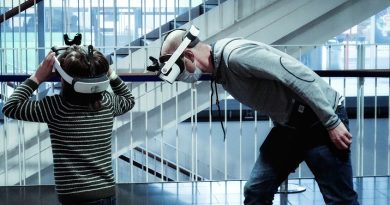Is Metaverse Ownership A (Virtual) Reality or A True Fiction?
There are numerous products available for purchase in the metaverse, in addition to merchandise and luxury items. Property purchases are booming, with plots being snapped up and investors paying millions for virtual land in the metaverse.
The metaverse is a network of virtual reality worlds where users can interact online through real-world-like activities such as working, learning, shopping and socializing via their “avatars.” It is a three-dimensional version of the internet, or, as it has been grandly described, “a virtual extension of the real world.”
The metaverse network is made up of various platforms. The Sandbox, Decentraland, Cryptovoxels, and Somnium Space are some of the major platforms on the metaverse right now, but it is a growing network, so there is room for many more to join. As part of the metaverse network, existing entities such as the gaming platforms Fortnite and Roblox are evolving.
What Metaverse Merchandise Is Available?
According to some estimates, more than $80 billion is spent each year on virtual goods, which is more than the amount spent on music. To date, much of this has been spent on in-game purchases, but there is a rapidly growing market for purchasing virtual goods outside of the computer game environment that may have greater real-world resale value.
Famous people are getting involved. Nike recently collaborated with the Roblox gaming platform to create Nikeland, a virtual world in which you can play sports and dress your avatars in Nike-branded shoes and clothing.
Other examples include Arianne Grande’s Fortnite concert and Hyundai’s Roblox metaverse mobility experience highlighting future mobility solutions. Dolce & Gabbana, DKNY, and Tommy Hilfiger participated in the first Virtual Fashion Week earlier this year on the metaverse platform Decentraland. The opening of Selfridge’s digital flagship store in Decentraland, a digital iteration of its real-world Birmingham store, displaying art NFTs for purchase, was part of the event.
You could also collect NFT artwork featuring fashion brand logos in the Virtual Fashion Week space, buy and wear virtual shoes to use on a gaming platform, or buy an AR version of the shoes to “wear” via your mobile phone.
There are numerous products available for purchase in the metaverse, in addition to merchandise and luxury items. Property purchases are booming, with plots being snapped up and investors paying millions for virtual land in the metaverse.
It is unclear how the use of online “buildings” will evolve. It is analogous to purchasing advertising space or a billboard in the real world. PricewaterhouseCoopers, for example, has purchased a plot in The Sandbox that will serve as a “web 3 advisory hub.” Snoop Dogg is creating a Snoopverse in The Sandbox platform, and a buyer reportedly paid $450,000 to be Snoop’s neighbor.
The Principles of Mechanics
How does it function? Each item of metaverse real estate is created as a virtual plot or “parcel” for metaverse property sales. Each parcel exists as a non-transferable asset (NFT) on the blockchain. Connecting the property parcel to the NFT is the digital equivalent of a property deed.
Other metaverse purchases, such as artwork and video clips, are represented by the NFT in the same way that you might get a paper receipt from a store when you buy goods in the real world. The important thing to remember is that the NFT does not represent the digital asset itself; it is only a record of metaverse ownership, and the image file will be hosted somewhere else, outside of the blockchain. Because of the size and computational cost of storing the content on the blockchain (the.JPG, MP3, Gif), the actual content of the NFT is typically stored on the web. In most cases, the NFT will include a link to the digital asset’s location.
Is It Possible to Own Something?
In the case of Osborne vs. Ozone Networks Inc. t/a Opensea decided in May of this year, the UK High Court ruled that NFTs are private property. The Claimant’s digital wallet was robbed of two Boss Beauties artwork NFTs. The NFTs had artistic value as images, but they also had other value in terms of access to events, free goods, and licensing fees, and they had a commercial value of around $4000. The location of the stolen NFTs was quickly traced (thanks to the blockchain’s transparent auditing potential), but the identity of the wallet holders of the transferred stolen NFTs is unknown, so the Court issued a freezing injunction against “persons unknown” prohibiting further transfer of the NFTs.
The case did not examine the link between the NFT and the underlying content that the NFT represents because it was outside the scope of the remedy requested. The case confirms and reassures that NFTs are property, but the status and safety of the asset itself, held apart from the blockchain, is another matter.
In the case of metaverse use, the visual or audio elements of the virtual assets that you have purchased are stored separately from the blockchain and are controlled by the metaverse platforms. They may potentially delink your assets from the NFT under the terms of service of metaverse platforms.
So, in addition to the risk of a digital purchase losing value, there are arguably risks associated with your ability to access digital goods. For example, The Sandbox reserves the right to delete your NFT’s images from its platform if you violate their terms, and states that “We reserve the right to remove Assets and Games from the Services, in whole or in part, without prior notice, for any reason or for no reason at all.” So, while your NFT “receipt” on the blockchain is unmistakable proof of your asset purchase, the asset itself is not. Changes to a metaverse platform’s terms and conditions after the purchase of an asset may make your purchase vulnerable in an ever-changing environment.
Customer Beware
Is it worth the risk? The purchase of any asset, real or virtual, is arguably risky. “Real monetary value should only be attached to virtual goods that provide real utility for their owners, otherwise there is a huge risk of creating a speculative bubble that will hurt consumers and companies,” said Artur Sychov, founder and CEO of Somnium Space. Purchasing virtual real estate in the metaverse has been compared to the dotcom gold rush. Despite some risks, interest is growing, and, to paraphrase Snoop Dogg, as of the end of last year:
“We are on the verge of a digital revolution.” “Get up and get it.”



